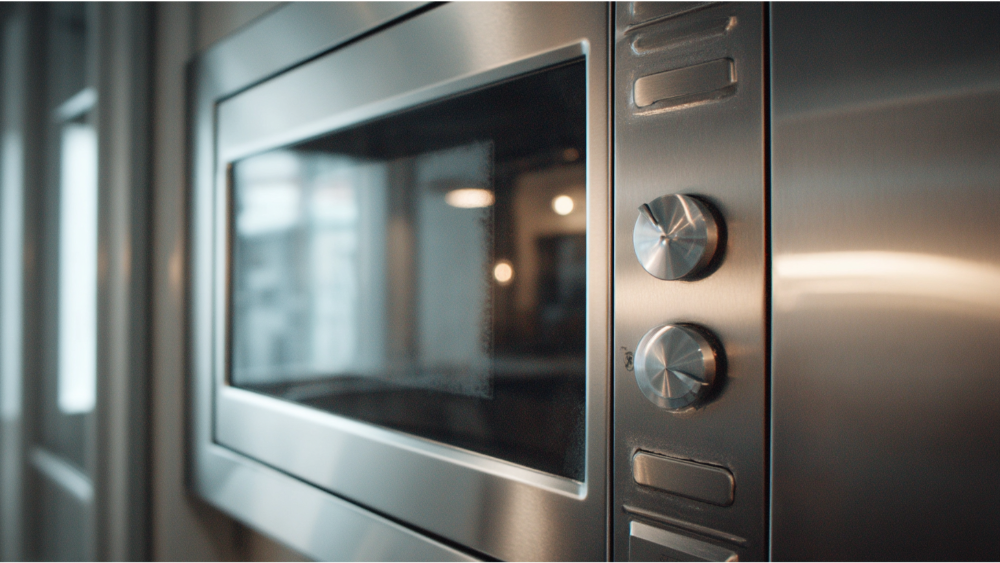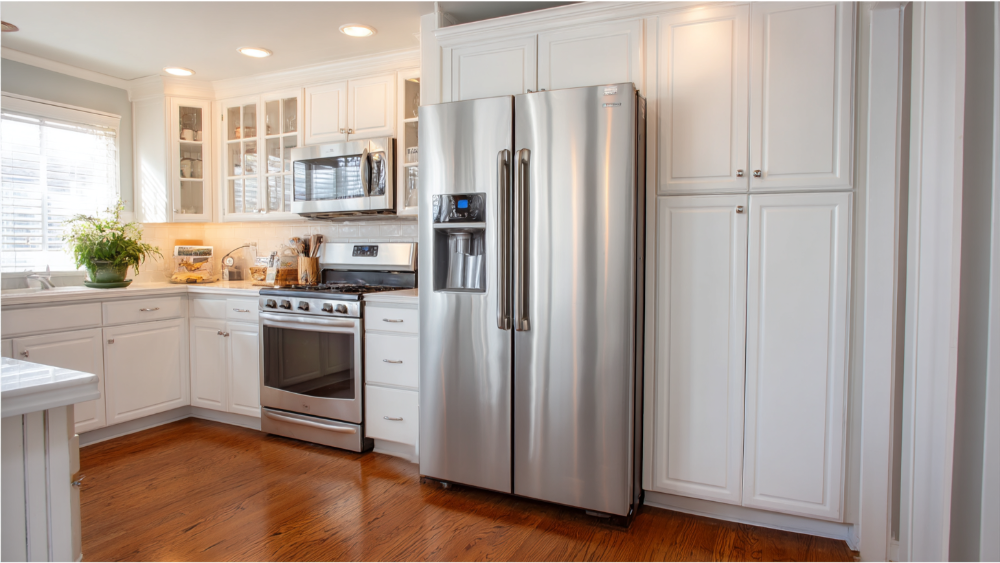
Stainless steel appliances bring style and sophistication to any kitchen, but if you own them, you already know how tricky they can be to maintain. Fingerprints, smudges, and water stains can quickly dull their shine. That’s why learning how to clean stainless steel appliances the right way is essential to keeping your kitchen looking fresh and polished.
At America’s Advantage Remodeling, we understand how important it is for your kitchen to look as clean as it functions. This guide will show you everything you need to know about how to clean stainless steel, from daily touch-ups to deep cleaning solutions, using safe techniques and the best stainless steel cleaners available in 2025.
Why Stainless Steel Needs Special Care

Stainless steel is a durable, non-porous material that resists rust and corrosion, but it does show fingerprints, smudges, and stains easily. Unlike other surfaces, the finish on steel appliances can be permanently damaged by the wrong cleaning products. Harsh chemicals, steel wool pads, or even glass cleaner with ammonia can leave streaks or scratches that are difficult to repair.
You also need to follow the direction of the grain on your stainless steel surface. Whether you are cleaning a stainless steel refrigerator or a dishwasher, always wipe in the direction of the grain using a soft cloth or microfiber cloth. This method helps protect the finish and maintain that like-new gleam.
Everyday Cleaning for Stainless Steel Appliances
What You’ll Need
- Warm water
- Dish soap
- Spray bottle
- Microfiber cloth
- Dry cloth or soft microfiber cloth
Step-by-Step Method to Clean Stainless Steel
- Mix your solution: Add a few drops of mild dish soap to warm water and pour the mixture into a spray bottle.
- Spray and wipe: Lightly spray the soapy water onto the stainless steel surface and gently rub with a microfiber cloth in the direction of the grain.
- Rinse: Wipe clean using a clean cloth dampened with plain warm water.
- Dry immediately: Use a dry cloth or paper towel to wipe dry and remove remaining streaks.
- Polish if needed: Apply a small amount of mineral oil or baby oil with a soft cloth to add shine.
Maintenance Tip
Use a clean microfiber cloth every time you clean to avoid scratching the surface. Regular cleaning once or twice a week can help prevent buildup and reduce the need for harsh scrubbing or elbow grease later on.
Deep Cleaning Stainless Steel Appliances

Even with regular upkeep, you’ll need to clean stainless steel appliances more thoroughly on occasion to remove rust, water stains, or stubborn stains from grease and spills.
Best Stainless Steel Cleaners in 2025
- Bar Keepers Friend Stainless Steel Cleaner
- CLR Stainless Steel Spray
- Weiman Stainless Steel Wipes and Polish
- Zep Stainless Steel Polish
These stainless steel cleaners are designed to clean stainless steel without causing damage. They remove tough grime while restoring shine and leaving behind a protective coating.
How to Use Stainless Steel Cleaners
- Read the owner’s manual to confirm what cleaning products are safe.
- Spray the stainless steel spray directly on the surface.
- Gently rub using a clean microfiber cloth, moving with the direction of the grain.
- Let the cleaner sit for a few seconds for tough spots.
- Wipe dry with a dry cloth to prevent streaks or water spots.
Natural Alternatives for Cleaning
If you prefer a DIY cleaning solution, try these natural methods:
- Baking soda paste: Mix baking soda with water to make a paste and apply it to stubborn stains. Gently rub with a microfiber cloth and rinse with warm water.
- White vinegar: Spray undiluted white vinegar onto the appliance, then wipe with a clean microfiber cloth.
- Club soda in a spray bottle: Use as a quick rinse to wipe clean and add shine.
Finish with a few drops of baby oil or mineral oil on a soft cloth to polish stainless steel appliances.
How to Clean Specific Stainless Steel Appliances

Each appliance has its own set of challenges. From greasy stovetops to smudged refrigerators, knowing how to clean stainless steel appliances effectively requires attention to the appliance type and its daily use.
Stainless Steel Refrigerator
The stainless steel refrigerator is often the most touched appliance in the kitchen. Fingerprints around the handles and water stains near the dispenser are common. Spray a small amount of stainless steel spray or soapy water from a spray bottle directly on the surface. Use a clean microfiber cloth and gently rub in the direction of the grain. For polishing, apply a small amount of mineral oil or baby oil with a soft cloth, then buff with a dry cloth to add shine.
Stainless Steel Oven and Range
Grease and food splatter can make cleaning stainless steel ovens and stovetops a chore. Start with a mild cleaning solution using dish soap and warm water. For stubborn stains, apply baking soda paste and let it sit before gently scrubbing with a clean cloth. Never use steel wool or steel wool pads, as they can leave scratches that are difficult to remove.
Stainless Steel Dishwasher
Stainless steel dishwashers often collect water stains and soap residue around the bottom and edges. Use a spray bottle filled with white vinegar or a recommended stainless steel cleaner to wipe the surface. Always move in the direction of the grain and use a soft microfiber cloth. Follow with a dry cloth to wipe clean and prevent remaining streaks.
Stainless Steel Microwave
Clean stainless steel microwave exteriors with soapy water or a stainless steel spray. Wipe with a microfiber cloth and rinse with a clean cloth dampened with warm water. To polish stainless steel appliances like microwaves, apply a small amount of mineral oil and buff gently with a soft cloth.
Stainless Steel Cleaning Mistakes to Avoid
Learning how to clean stainless steel means avoiding common pitfalls. Using the wrong tools or cleaning products can do more harm than good.
- Avoid harsh chemicals: Ammonia-based glass cleaner, bleach, and other harsh products can damage the stainless steel surface.
- No steel wool: Steel wool and abrasive pads will scratch and dull your appliances.
- Don’t skip drying: Leaving moisture behind can cause water stains or leave streaks.
- Never wipe against the grain: Always follow the direction of the grain to prevent damage.
- Avoid using the same cloth: A dirty or rough cloth can redistribute grime and leave streaks.
Use only safe, approved cleaning products or natural alternatives, and always finish with a clean microfiber cloth.
Tips for Maintaining the Shine of Steel Appliances

To keep your kitchen looking sharp, you don’t need elbow grease every day. Simple habits go a long way when it comes to preserving the beauty of your stainless steel appliances.
- Daily wipe-downs: Use a spray bottle with soapy water or a commercial stainless steel cleaner to wipe away smudges.
- Weekly polishing: Apply a small amount of baby oil or mineral oil to a soft cloth, then buff your appliances for added protection and shine.
- Monthly deep cleaning: Use specialized stainless steel cleaners like Bar Keepers Friend or CLR stainless steel spray to clean stainless steel deeply and remove tough residue.
- Switch to microfiber: Always use a soft microfiber cloth to avoid scratches and streaks.
- Clean immediately after spills: Avoid letting food or liquids sit too long, especially on oven doors or dishwasher edges.
Frequently Asked How to Clean Stainless Steel Appliances Questions
What’s the best way to clean stainless steel appliances?
Use dish soap and warm water for daily cleaning. For deeper cleans, use stainless steel cleaners like Weiman or Bar Keepers Friend. Always wipe with the grain using a microfiber cloth.
Can I use baking soda to clean stainless steel?
Yes, baking soda mixed with water forms a gentle cleaning paste. Apply it to stubborn stains and wipe with a clean microfiber cloth. Rinse with warm water and dry thoroughly.
Is vinegar safe for stainless steel?
White vinegar is safe when used correctly. It can help dissolve hard water stains and restore shine. Always wipe clean and dry after using vinegar to avoid streaks.
How often should I clean stainless steel appliances?
Wipe down your steel appliances daily or every few days depending on usage. Polish them weekly and perform a deep clean once per month to remove residue and add shine.
What cloth should I use?
Use a clean microfiber cloth or soft microfiber cloth every time. Avoid paper towels, which can leave lint, and never use steel wool or abrasive cloths.
When It’s Time for More Than Just Cleaning
Sometimes, even the best stainless steel cleaners can’t cover up years of wear and tear. If your appliances are outdated, dented, or no longer match your kitchen’s aesthetic, it might be time to consider a full remodel. At America’s Advantage Remodeling, we offer custom kitchen remodeling solutions that combine modern design, functionality, and the durability you need for a busy household.
Explore our kitchen remodeling services and project gallery to see how we transform everyday kitchens into polished, high-performance spaces.
Final Thoughts
Stainless steel appliances are a beautiful investment in your home, and with proper care, they can last for decades. Learning how to clean stainless steel appliances the right way ensures they stay streak-free, shiny, and protected from damage. Whether you use commercial stainless steel cleaners or natural methods like baking soda and white vinegar, consistency is key.
Avoid harsh chemicals and steel wool, stick with microfiber cloths, and always clean with the direction of the grain. With these tips and tools, you can clean stainless steel like a pro and enjoy a kitchen that looks as good as it performs.
Need help refreshing your space or upgrading your appliances? Contact America’s Advantage Remodeling today to bring lasting shine and style to your kitchen.
CONTACT US
Our Services
Areas We Serve
Certificate






